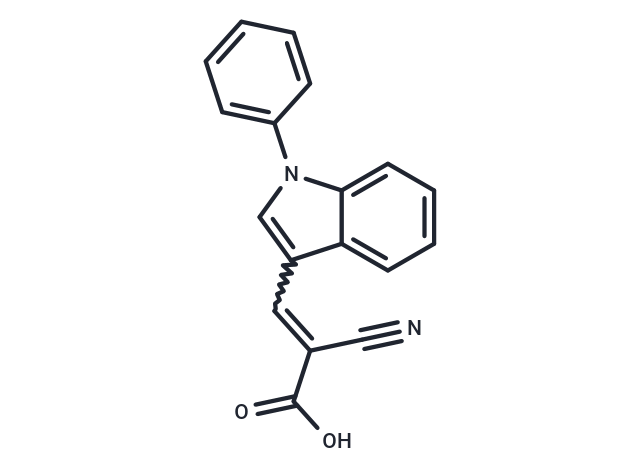Shopping Cart
Remove All Your shopping cart is currently empty
Your shopping cart is currently empty
UK-5099 (PF-1005023) is a specific and potent inhibitor of MPC carrier activity, effectively inhibiting pyruvate-dependent oxygen consumption in rat heart mitochondria with an IC50 of 50 nM [1].

| Pack Size | Price | USA Warehouse | Global Warehouse | Quantity |
|---|---|---|---|---|
| 1 mg | $30 | In Stock | In Stock | |
| 5 mg | $62 | In Stock | In Stock | |
| 10 mg | $89 | In Stock | In Stock | |
| 25 mg | $177 | In Stock | In Stock | |
| 50 mg | $296 | In Stock | In Stock | |
| 100 mg | $449 | In Stock | In Stock | |
| 500 mg | $987 | Inquiry | Inquiry | |
| 1 mL x 10 mM (in DMSO) | $71 | In Stock | In Stock |
| Description | UK-5099 (PF-1005023) is a specific and potent inhibitor of MPC carrier activity, effectively inhibiting pyruvate-dependent oxygen consumption in rat heart mitochondria with an IC50 of 50 nM [1]. |
| Targets&IC50 | MPC:50 nM |
| In vitro | The trypanosomal pyruvate carrier is found to be rather insensitive to inhibition by alpha-cyano-4-hydroxycinnamate (Ki: 17 mM) but can be completely blocked by UK-5099 (Ki: 49 μM)[2]. UK-5099 also inhibits the monocarboxylate transporter (MCT) [3]. UK5099 dose-dependently significantly inhibits the glucose-stimulated rise in oxygen consumption and at 150 μM reduced oxygen consumption below basal levels. UK5099 reduces ATP levels and increases ADP and AMP levels in 832/13 cells[4]. The UK5099 treated cells show a significantly higher proportion of side population fraction and express higher levels of stemness markers Oct3/4 and Nanog. The UK5099 application may be an ideal model for Warburg effect studies[5]. |
| In vivo | UK5099 increases the glucose excursion seen during an intraperitoneal glucose tolerance test in C57BLK mice[4]. |
| Cell Research | The 832/13 cell line derived from INS-1 rat insulinoma cells is used for experiments. Cell viability is measured using CellTiter Blue. The assay is based on the cellular reduction of resazurin to resorufin. The appearance of resorufin is monitored by fluorescence emission at 585 nm using a Spectramax M5 microplate reader with excitation at 555 nm. For UK5099-treated cells, cells are allowed to recover for 1 h before measuring cell viability. Data are expressed as -fold relative to no treatment or siCtrl[4]. |
| Animal Research | C57BLK mice are fasted for 16 h prior to glucose challenge. UK5099 (32 μmol/kg of body weight) or DMSO in PBS is injected into the intraperitoneal cavity 30 min before injecting glucose (1.5 mg of glucose/g of body weight). Blood glucose levels are measured at 0, 10, 20, 30, 60, and 120 min after glucose injection[4]. |
| Synonyms | UK5099, UK 5099, PF-1005023 |
| Molecular Weight | 288.3 |
| Formula | C18H12N2O2 |
| Cas No. | 56396-35-1 |
| Smiles | OC(=O)C(=Cc1cn(-c2ccccc2)c2ccccc12)C#N |
| Relative Density. | 1.20 g/cm3 |
| Color | Yellow |
| Appearance | Solid |
| Storage | store at low temperature,keep away from direct sunlight | Powder: -20°C for 3 years | In solvent: -80°C for 1 year | Shipping with blue ice/Shipping at ambient temperature. | ||||||||||||||||||||||||||||||
| Solubility Information | DMSO: 16.67 mg/mL (57.82 mM), Sonication is recommended. | ||||||||||||||||||||||||||||||
| In Vivo Formulation | 10% DMSO+40% PEG300+5% Tween 80+45% Saline: 1.67 mg/mL (5.79 mM), Solution. Please add the solvents sequentially, clarifying the solution as much as possible before adding the next one. Dissolve by heating and/or sonication if necessary. Working solution is recommended to be prepared and used immediately. The formulation provided above is for reference purposes only. In vivo formulations may vary and should be modified based on specific experimental conditions. | ||||||||||||||||||||||||||||||
Solution Preparation Table | |||||||||||||||||||||||||||||||
DMSO
| |||||||||||||||||||||||||||||||
| Size | Quantity | Unit Price | Amount | Operation |
|---|

Copyright © 2015-2026 TargetMol Chemicals Inc. All Rights Reserved.